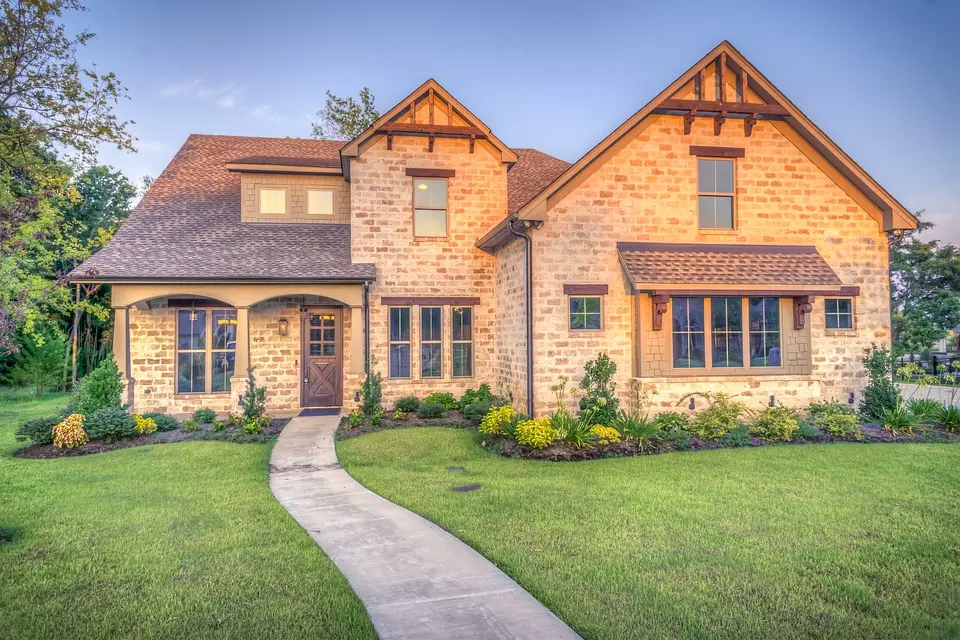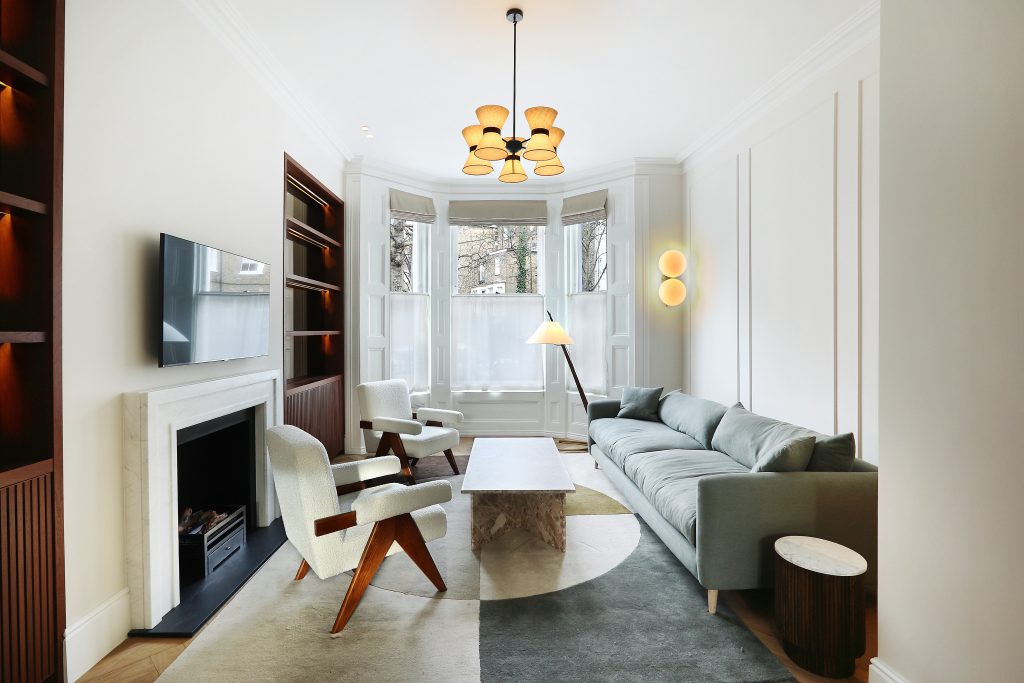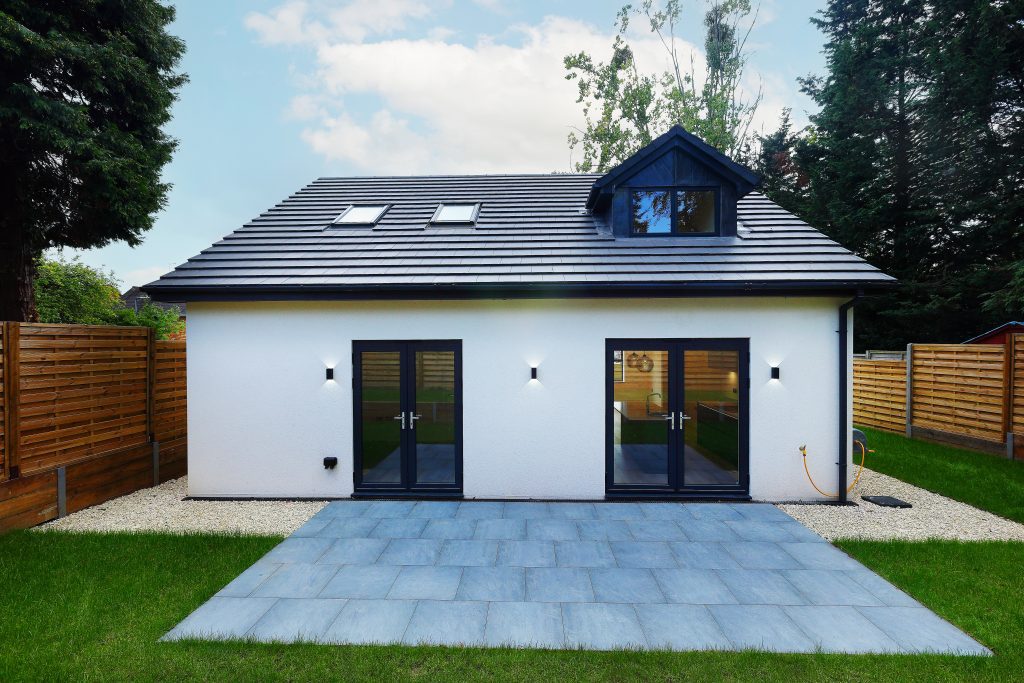Welcome to the world of house rendering! House rendering is one of the best options to increase the aesthetics and durability of your house. But what does rendering a house mean? How do you go about giving your beloved home a facelift?
Read this explainer guide to understand what rendering outside the house is and how it can improve your home’s lifespan and attractiveness.
What is Rendering on a House?
Exterior house rendering refers to the process of applying a coating on the exterior wall of the house.
Render is different from plaster, which is essentially used on internal walls. From a traditional lime render to a modern polymer render or anything in between, homeowners can choose from different types of render if they decide to invest in a house render project.
Choosing an experienced London refurbishment company to handle your property’s rendering is essential for beautiful results.

The Importance of House Rendering
Why should you render a house?
Over the years, your home will likely see age-related problems that can weaken the exterior, reduce the insulation, and make it vulnerable to bad weather. Think of property rendering as the first line of defense for the exterior of your home against dampness and mold. Besides, it also has the visible effect of improving the house’s appearance.

The Role of Rendering in Protecting and Insulating Your Home
- Exposure to the sun, rain, and snow may result in older properties losing some resistance to these elements.
- Rendering house exteriors ensures that the life span of the home increases.
- Renders to the house can provide a coating that will keep out algae and moss from the exterior surface.
Enhancing Your Home’s Appeal with Rendered House Techniques
- Front-of-house rendering is a practical solution to covering up the flaws in the original structure, such as shabby exposed brickwork or cracks in the exterior of the building.
- If you plan to add new structures to the house, then besides searching for extension builders near me, look for a competent rendering UK company to ensure that the extended structure blends in with the original one.
Types of House Rendering: Exploring Your Options
Now that you have decided to render the house exterior, you will be happy to note that there are a host of options to choose from.

Here is a snapshot of the best available render options that you can consider for your external walls.
Cement Render:
A popular and cost-effective type of house render, cement render uses a mix of cement and sand to achieve a smooth finish on exterior walls. It requires two or three coats of application and a good amount of expertise to apply them.
Lime Render:
A favourite for restoring period properties, a lime render is an eco-friendly and breathable solution for rendering on house exteriors. It uses a mixture of lime, sand, and water without allowing dampness to be trapped within the walls.
If you are considering home renovation ideas for your aging home but want to preserve its classic look, then traditional lime render is what you should consider.
Acrylic Render:
Acrylic renders on the house act like cement renders, but the inclusion of acrylic, a plastic derivative, enhances the “sealing” properties of the render. Durable and vibrant acrylic renders are popular as they come in various colours, patterns, and textures.
Silicone Render:
Silicone render is a modern, durable render option. This thin-coat polymer render is highly water-resistant and breathable. With self-cleaning properties, it promises to wash away dirt quickly when it comes in contact with rain.
Monocouche Render:
The French word” monocouche” means “single layer” or “bed.” Monocouche render is a dry powder with coloured pigments, offering a rough, textured finish. This white cement-based render comes premixed in bags and requires only a single coat of application
Comparing Different Renders: Pros, Cons, and Costs
When it comes to house rendering, look at the pros, cons, and costs of each option before making a decision.
Cement Render
| Pros | Cons |
| ✅Suitable for harsh weather conditions ✅Works as a sound insulator ✅Durable | ❌Rigid material ❌Only suitable for solid surfaces ❌Prone to cracking if not applied well ❌May require frequent maintenance |
| Cost: Material cost is less; it requires multiple coats and can be labour-intensive. | |
Lime Render
| Pros | Cons |
| ✅Environmental friendly ✅Flexible ✅Breathable ✅Relatively low maintenance | ❌More expensive than lime renders ❌Requires skilled labour for the application ❌Requires periodic lime washes to preserve the look |
| Cost: More expensive as it requires an expert application. | |
Acrylic Render
| Pros | Cons |
| ✅Available in a variety of colours ✅ Less prone to cracking and fade-resistant ✅Protects against UV rays ✅Easy to apply | ❌Not breathable ❌Not environment-friendly |
| Cost: Mid-priced | |
Silicone Renders
| Pros | Cons |
| ✅Durable ✅Water repellent ✅Breathable ✅comes in a variety of colors and finishes | ❌The application can take time ❌Repairs can be complex, ❌Not eco-friendly |
| Cost: Expensive, but its high performance can help mitigate the cost in the long run. | |
Monocouche Render
| Pros | Cons |
| ✅Can be used for any exterior surface ✅Easy to use ✅Economical ✅Durable ✅Does not require painting to produce textured effects | ❌Not very crack-resistant ❌Waterproof but not water-repellent ❌Requires regular cleaning ❌Can fade and discolour over time |
| Costs: While the material is expensive, it is affordable as it is not labour intensive. | |
What type of external house rendering should you choose
You are now aware of the plus points, problems, and pitfalls of the different types of renders available in the market. You can pick a render that is suitable to your requirements and budget.
Do keep in mind that rendering costs will depend on
➡️The location of your home
➡️The type of property
➡️The size of the home
➡️The complexity of the project
➡️The conditions of the wall
- While lime and cement renders offer traditional rendering on the house, acrylic silicone and monocouche are modern renders that provide various colour and texture options for walls. Silicone may require a higher initial investment, but its durability can average out these costs.
- Monocouche renders are a great choice for quick application options on contemporary and traditional buildings.
Acrylic renders are adaptable to varying weather conditions and can be applied over almost any kind of exterior surface.
House Rendering Techniques and Styles
There is no one-size-fits-all solution when considering house rendering exteriors. Let us look at some unique styles and techniques that are sure to enhance the visual appeal of homes while protecting them.

Rendering Front of the House for Maximum Impact
A complete home exterior rendering may seem time-consuming and expensive. You can consider rendering the front of your home to elevate its value. A rendered property is also a sign of a well-kept and cared-for home.
Creative Ideas for Rendering Outside of the House
The design aspect of rendering involves experimenting with fresh ideas to give the house a stand-out look.
- Consider a partial render to break the monotony of plain external walls.
- Render one external wall and make it a unique feature of your home.
- Mix and match different rendering materials; natural stone cladding and wood can add character and uniqueness.
- Go with warm hues and muted colors instead of white exterior walls.
Unique Textures and Finishes: Making Your Home Stand Out
You can be “adventurous “and explore different colours, textures, and finishes while planning your project.
- Scratched textures give a rough look to exteriors.
- Fine scraped textures offer smooth and cleaner finishes.
- Pebble dash creates a stone facade.
- Tyrolean produces a honeycomb texture on walls.
Planning and Preparation for House Rendering
Now that you have gained rudimentary knowledge of rendering essentials, it’s time to get to the practical aspects, such as planning and permission.

Do You Need Planning Permission for House Rendering?
- You do not need planning permission to render your house. However, it may be required if you live in a conservation area.
- The choice of colors may also have to be based on RAL or British Standard colours if you are a part of specially listed properties.
- You must adhere to building regulation norms while planning a rendering project.
Assessing Your House Type for Suitable Rendering
Not all rendering materials are suitable for all types of houses. A lime render is best suited to porous walls, while a silicone render may be the best option for wood and brick houses. Your house type should be the first factor under your renovating a house checklist because it will determine your style, material, and budget.
Rendering Brick, Timber-Framed, and Terraced Houses
Brick or block homes can be protected with the help of lime wash, acrylic, or silicone renders. However, for timber framed houses, choose a material that does not lead to mould problems. Terraced houses may be tricky as it is imperative to match the style of neighbouring houses.
The Challenge of Rendering Pebble Dash Houses
Pebble dash is less breathable, and moisture can remain between the pebbles and the fresh render. Whether you want to re-do the pebble dash, go with a coloured render, or even repaint the pebble dash is a question of choice.
The Practical Side of House Rendering
Now that you know what is render on the house, you may have some questions regarding the practical aspects of home rendering.

Can You Render Your House Yourself? A DIY Guide
A House rendering job requires a lot of skill and practice. If the work is shabby, it can make your home’s exterior look shoddy and reduce its value. It is a good idea to get a skilled tradesperson to take up the rendering job of your home .
However, if you do decide to take up the rendering of your home, consider the following tips:
- Start small
- Choose a simple and easy-to-apply render
- Invest in high-quality tools and equipment
Weather and Rendering: Best Practices and Tips
Start your home rendering project under optimum weather conditions. While rain and frost are an absolute no-no, hot weather may cause the rendering mix to set too soon. A nice cloudy day with moderate temperatures in late spring or early summer is ideal.
How Long Does House Render Last? Durability and Maintenance
The life span of renders depends on the material used and the quality of workmanship. Most renders last for 15 to 20 years, with high-performance ones like silicone lasting up to 30 -40 years. However, gently cleaning it once every few years is advisable to extend its life.
The Cost of Rendering a House: Budgeting for Your Project
Rendering the front of your home is a one-time investment. This cost may look huge to you. However, it is worth it because it will reduce maintenance costs in the future.
Consider these as ballpark estimates to help you budget your rendering project.
| Type of Render | Price Range |
| Cement | £1000-£3000 |
| Lime | £2000-£6000 |
| Acrylic/Silicone | £3000-£9000 |
| Monocouche | £3500-£10,500 |
The Benefits of Rendering Your House
One of the prime advantages of external house rendering is that it protects the house from the elements and makes it “all-weather” proof. Undoubtedly, a well-rendered property is attractive and will earn accolades from everyone.

Does Rendering Add Value to Your Home?
Rendering can help a house age gracefully. Rendering on a house can prevent dampness and moisture from settling into its bones and spoiling its good looks. It can also keep the house” healthy,” both of which will improve property values.
House Render for Insulation and Energy Efficiency
Modern renders help to insulate the house by improving the energy efficiency of the exterior wall, reducing heating loss. Protective render helps reduce energy consumption and can help bring down your energy bills considerably.
The Aesthetic Transformation of Rendering Your House
Front-of-the-house rendering is a prudent way to increase the attractiveness of your home. Adding exciting colours, textures, and unique exterior finishes to the house is an excellent way to give it a new look.
Fittra: Your Trusted Construction Partner in House Rendering

Rendering is a skilled job meant for seasoned professionals. We at Fittra fit the bill when it comes to any rendering UK for the exterior of your home.
Why Choose Fittra for Your Rendering Needs
As an NHBC-certified construction company with over ten years of experience in the construction industry, we can help you complete your home rendering project at a competitive price.
The Advantages of Working with Fittra
No matter how big or small your project, our team of experts guarantees that our focus on quality and customer satisfaction will ensure you are happy with your newly rendered home.
Here are some top reasons why you should contact Fittra right away.
Comprehensive Services: From Extensions to New Builds
Fitrra professionals have the expertise and skill to deal with all kinds of construction projects, from new builds and refurbishments to house renovation London.
The Fittra Difference: Comprehensive Construction Solutions with Experience and Quality
Our professionalism, skill, experience, and emphasis on quality guarantee that you will be happy with the end product.
Fittra’s Seamless Processes and Commitment to Customer Satisfaction
Fittra is a reputed name in construction. We have perfected the art of end-to-end construction with streamlined processes that ensure timely delivery and happy customers.
Expert Tips and Considerations in House Rendering
As a homeowner, knowing the best ways to complete a render on your house is a good idea. Knowing the hiccups you may face can also help you be vigilant and cautious.
Choosing the Right Rendering System for Your Home
Research what’s available in the market and understand the type and substrate on your walls. While style and price are top considerations, choosing materials that will stick to and protect the substrate is important.
Addressing Common Challenges in House Rendering
While we wish your house rendering project works out seamlessly, paying close attention to three key elements can reduce problems while rendering.
Importance of Surface Preparation
Improperly prepared walls can lead to peeling and flaking render. Removing dust, dirt, and flaky paint is essential to ensure better render adhesion and increase its durability.
Preventing and Managing Cracks
Mixing the render in the correct ratio, applying it skillfully, and curing it appropriately can reduce the possibility of cracks developing. Regular inspection can help to arrest small cracks that evolve.

Weather Considerations and Maintenance Tips
Take up the project during good weather because extreme weather conditions can impact the quality of the finished product. Regular exterior inspection and a periodic cleaning schedule can increase a rendered property’s longevity and good looks.
Conclusion
This explainer guide tells you everything you need to know about rendering -benefits, types, and costs to help you find the right render for your beloved home.
Summing Up: The Impact of Rendering on Your Home
Rendering on your home is one of the best options if you want the benefits of protection and attractiveness for your home. Your home can increase its looks and value from rendering. Improved insulation and reduced energy bills that rendering can provide a definite advantage when a home is rendered.
So, do call a skilled contractor to start your rendering job.
Frequently Asked Questions (FAQs)
What Does Rendering a House Mean?
Rendering a house means adding a thick coating over the external walls of a home. This can make it weather-resistant and enhance its life.
How do you choose the right render for your property?
The right render is to be chosen based on
– the type of property
– the age of the property
– the rendering style you want
– the budget
What is the Best Time of Year to Render a House?
Rendering needs pleasant weather. Extreme weather conditions are not conducive to rendering.
How Long Does it Typically Take to Render a House?
The time taken for a house rendering project depends on its size. Generally, it can take from one day to two weeks to render a home.
Can House Rendering Improve Energy Efficiency?
House rendering can improve energy efficiency by providing a layer of insulation on the exterior walls, reducing heat loss.
What are the Latest Trends in House Rendering Colors and Styles?
The latest trends in home rendering are
– minimalistic exteriors,
– the use of organic material, and
– different shades of blues
How Does House Rendering Compare to Other Exterior Finishes in Terms of Durability?
The life of a rendered exterior wall increases by more than 10 years. This makes it a better option compared to other exterior finishes.







